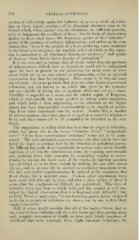Page 706 - My FlipBook
P. 706
716 GENERAL PATHOLOGY.
version of cell-activity under the influence of, or as a result of, irrita-
tion or tissue injury, products of an abnormal character seem to be
formed which, when carried into the circulation in sufficient quantity,
serve to inaugurate the condition of fever. On the basis of observations
"
similar to those cited above Dr. Sanderson speaks of the " infective
power of the products of ordinary inflanuuation, and arrives at the con-
clusi
ism is antecedent to all functional disturbance whatever ;" and speaks
of fever as " from first to last a disorder of protoplasm."
It is not necessary to suppose that all fevers result from the products
of infiannnation ; indeed, such an hypothesis could not be maintained
upon the facts at present in our possession, for many cases of fever
occur M-hicli are in no way related to inflammation, so far as physical
examination has thus far developed. This seems to be but one cause
out of many. It seems probable that there are other forms of perverted
cell-action, not yet known to us, which take place in the economy
and are capable of giving rise to products which may act as a cause.
Putridity is regarded as a cause, and the soluble sepsin of Bergman,
which is undoubtedly the waste product of certain micro-organisms,
and which holds a close relationship to the alkaloids of the higher
plants, has been demonstrated experimentally to be capable of produ-
cing fever \\hen introduced into the system. Besides this, a number
of micro-organisms have been proved to stand in a causative relation to
fever, and other causes will in all probability be identified in the near
future.
The supposition so widely held that fever has its origin in irritation,
which has given rise to the terms "irritative fever," "^sympathetic
fever," " fever from constitutional irritation," seems not to be main-
tained. The most persistent experimentation with that end in view has
failed (in dogs) to produce fever by the irritation of peripheral nerves.
Dr. I>illroth has made these experiments in various ways, as by forcible
injectit)ns of air into the subcutaneous tissue, by exposing nerve-trunks
and irritating them with ammonia, by suspending weights to nerve-
trunks, by tearing the inner coats of the vessels, by injecting powders
into the blood so as to form emboli, by rubbing the ears with croton
oil, etc., and in no case did he succeed in producing immediate fever.
On this and similar experimentation he arrived at the conclusion that
fever always has a material cause. Various other experiments have
been made with this end in view, and after a close review of them it
seems that the conclusions of Billroth are maintained. This idea of
irritative fever has been so widely held, and has seemed so well sus-
tained by clinical observation, that it is displaced with difficulty ; but,
as Prof. Wood sf) ajitlv says, "as our knowlege grows, fevers supposed
to be due to peri])heral irritations are shown, one by one, to have their
origin in toxicmia."
Still, it seems hardly possible that all of the fugitive fevers that we
see, many of them enduring only for a few hours and then passing away
with complete restoration of health, or those mild febrile reactions of
childhood that arise seemingly from slight intestinal irritations, the


